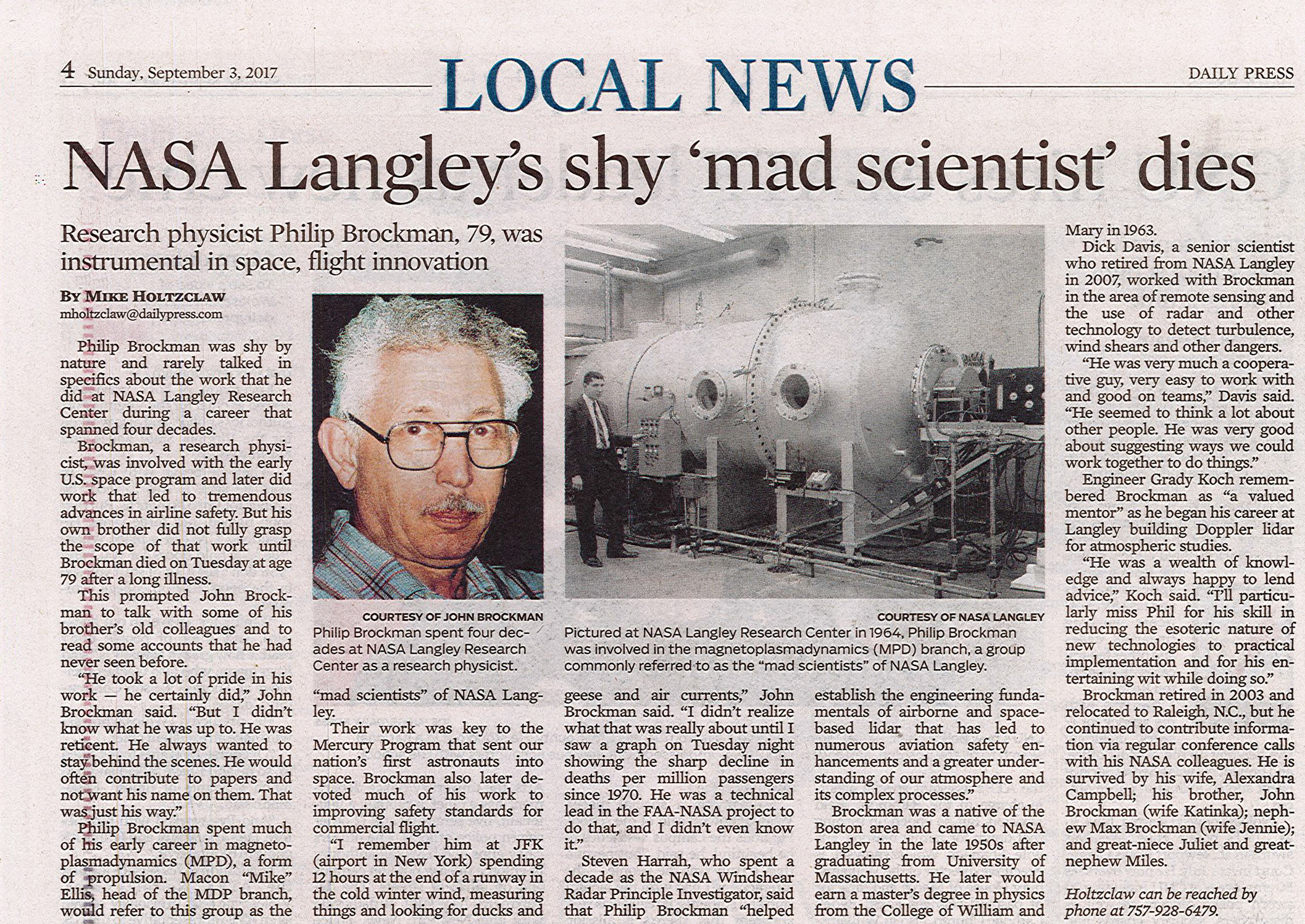
NASA Langley's shy 'mad scientist' dies
By Mike Holtzclaw [September 3, 2017]

Philip Brockman was shy by nature and rarely talked in specifics about the work that he did at NASA Langley Research Center during a career that spanned four decades.
Brockman, a research physicist, was involved with the early U.S. space program and later did work that led to tremendous advances in airline safety. But his own brother did not fully grasp the scope of that work until Brockman died on Tuesday at age 79 after a long illness.
This prompted John Brockman to talk with some of his brother’s old colleagues and to read some accounts that he had never seen before.
“He took a lot of pride in his work — he certainly did,” John Brockman said. “But I didn’t know what he was up to. He was reticent. He always wanted to stay behind the scenes. He would often contribute to papers and not want his name on them. That was just his way.”
Philip Brockman spent much of his early career in magnetoplasmadynamics (MPD), a form of propulsion. Macon “Mike” Ellis, head of the MDP branch, would refer to this group as the “mad scientists” of NASA Langley.
Their work was key to the Mercury Program that sent our nation’s first astronauts into space. Brockman also later devoted much of his work to improving safety standards for commercial flight.
“I remember him at JFK (airport in New York) spending 12 hours at the end of a runway in the cold winter wind, measuring things and looking for ducks and geese and air currents,” John Brockman said. “I didn’t realize what that was really about until I saw a graph on Tuesday night showing the sharp decline in deaths per million passengers since 1970. He was a technical lead in the FAA-NASA project to do that, and I didn’t even know it.”
Steven Harrah, who spent a decade as the NASA Windshear Radar Principle Investigator, said that Philip Brockman “helped establish the engineering fundamentals of airborne and space-based lidar that has led to numerous aviation safety enhancements and a greater understanding of our atmosphere and its complex processes.”
Brockman was a native of the Boston area and came to NASA Langley in the late 1950s after graduating from University of Massachusetts. He later would earn a master’s degree in physics from the College of William and Mary in 1963.
Dick Davis, a senior scientist who retired from NASA Langley in 2007, worked with Brockman in the area of remote sensing and the use of radar and other technology to detect turbulence, wind shears and other dangers.
“He was very much a cooperative guy, very easy to work with and good on teams,” Davis said. ”He seemed to think a lot about other people. He was very good about suggesting ways we could work together to do things.”
Engineer Grady Koch remembered Brockman as “a valued mentor” as he began his career at Langley building Doppler lidar for atmospheric studies.
“He was a wealth of knowledge and always happy to lend advice,” Koch said. “I’ll particularly miss Phil for his skill in reducing the esoteric nature of new technologies to practical implementation and for his entertaining wit while doing so.”
Brockman retired in 2003 and relocated to Raleigh, N.C., but he continued to contribute information via regular conference calls with his NASA colleagues. He is survived by his wife, Alexandra Campbell; his brother, John Brockman (wife Katinka); nephew Max Brockman (wife Jennie); and great-niece Juliet and great-nephew Miles.
Continue reading "Philip Pushes the Button."
